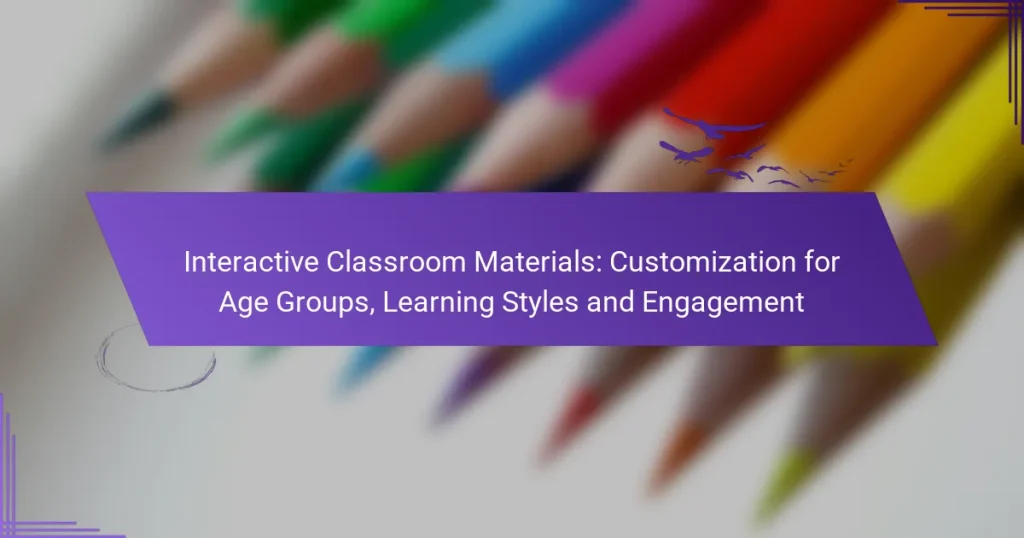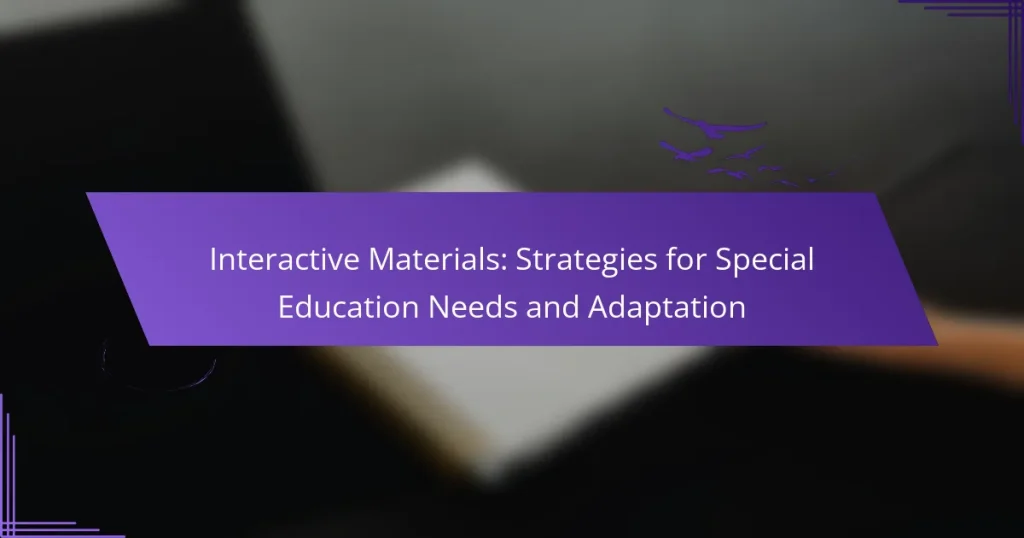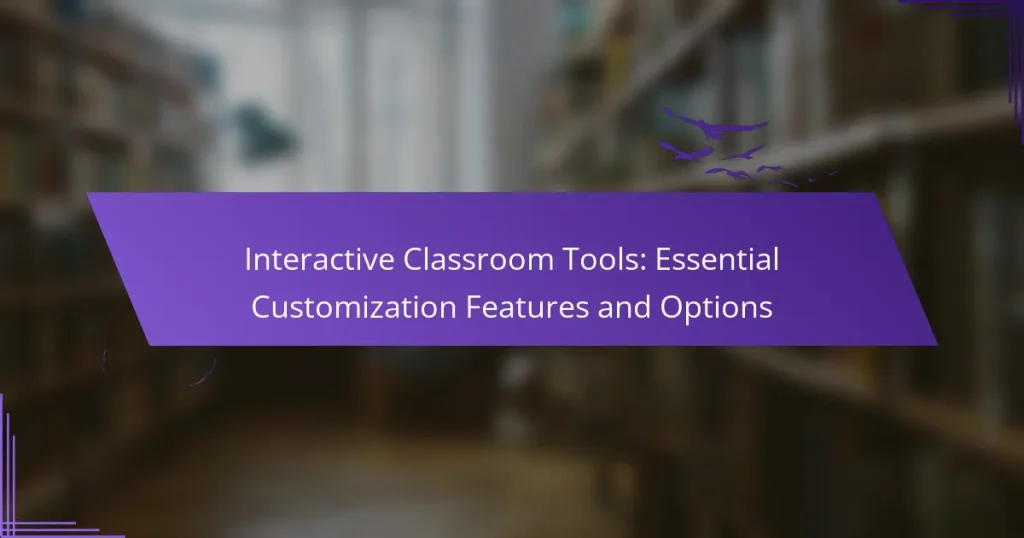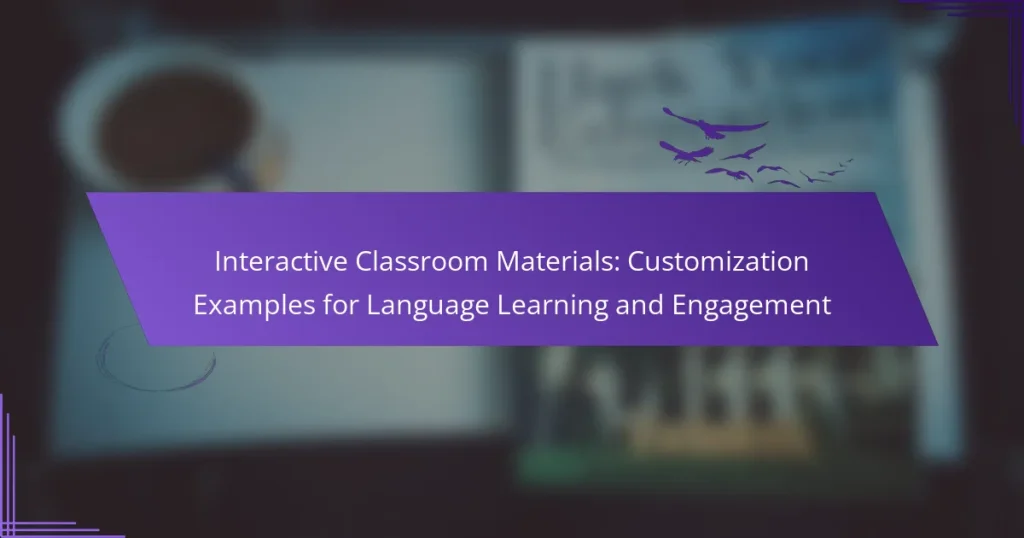Interactive classroom materials offer a variety of customization options that can significantly enhance student engagement and learning outcomes. By modifying templates, personalizing content, and integrating interactive features, educators can create tailored resources that meet the diverse needs of their students. This approach not only fosters a more engaging learning environment but also promotes personalized educational experiences.
Interactive Classroom Materials: Customization for Age Groups, Learning Styles and Engagement
Interactive Classroom Materials: Benefits of Customization for Student Engagement and Success
Interactive Materials: Strategies for Special Education Needs and Adaptation
Interactive Classroom Tools: Essential Customization Features and Options
Interactive Classroom Materials: Customization Examples for Language Learning and Engagement
Interactive Learning Experiences: Personalization Strategies, Techniques and Benefits
What customization options are available for interactive classroom materials?
Interactive classroom materials can be customized in several ways to enhance engagement and learning outcomes. Key options include template modifications, content personalization, branding integration, interactive features, and accessibility adjustments.
Template modifications
Template modifications allow educators to change the layout and design of interactive materials to suit their teaching style or classroom needs. This can include altering colors, fonts, and overall structure to create a more appealing visual experience.
When selecting templates, consider the age group of the students and the subject matter. For example, younger students may benefit from bright colors and playful designs, while older students might prefer a more professional look.
Content personalization
Content personalization involves tailoring the material to reflect the interests and learning levels of individual students. This can be achieved by incorporating relevant examples, images, or scenarios that resonate with the students’ experiences.
To effectively personalize content, gather information about your students’ preferences and backgrounds. This could involve surveys or informal discussions to ensure the material is relatable and engaging.
Branding integration
Branding integration allows schools or educational programs to incorporate their logos, colors, and other brand elements into interactive materials. This helps create a cohesive identity and can enhance the sense of community among students.
When integrating branding, ensure that it does not overshadow the educational content. The focus should remain on facilitating learning while maintaining a professional appearance.
Interactive features
Interactive features enhance engagement by allowing students to actively participate in their learning. These can include quizzes, drag-and-drop activities, and multimedia elements like videos or animations.
Consider the technological capabilities of your classroom when implementing interactive features. Ensure that all students have access to the necessary devices and internet connectivity to fully benefit from these enhancements.
Accessibility adjustments
Accessibility adjustments ensure that interactive materials are usable by all students, including those with disabilities. This may involve providing text alternatives for images, ensuring compatibility with screen readers, and using clear, simple language.
Follow established accessibility guidelines, such as the Web Content Accessibility Guidelines (WCAG), to create inclusive materials. Regularly seek feedback from students to identify any barriers they may encounter while using the materials.
How can teachers implement customized interactive materials in their classrooms?
Teachers can implement customized interactive materials by integrating technology and tailoring content to meet the diverse needs of their students. This approach enhances engagement and facilitates personalized learning experiences.
Step-by-step integration process
Begin by assessing the specific needs of your students and identifying the subjects or topics that require interactive materials. Next, select appropriate platforms or tools that allow for customization, ensuring they align with your curriculum.
Once you have chosen the tools, design the materials by incorporating multimedia elements such as videos, quizzes, and interactive simulations. Finally, test the materials with a small group of students to gather feedback and make necessary adjustments before full implementation.
Best practices for customization
Focus on clarity and simplicity when customizing interactive materials. Use straightforward language and intuitive layouts to ensure that students can easily navigate the content. Incorporate elements that cater to different learning styles, such as visual aids for visual learners and interactive tasks for kinesthetic learners.
Regularly update and refine your materials based on student feedback and performance data. This iterative process helps maintain relevance and effectiveness, allowing you to adapt to changing educational needs.
Tools for creating interactive materials
Several tools can assist teachers in creating customized interactive materials. Platforms like Google Slides and Canva offer user-friendly interfaces for designing engaging presentations and activities. For more advanced interactivity, consider tools like Nearpod or Edpuzzle, which allow for embedding quizzes and interactive elements directly into lessons.
Additionally, learning management systems (LMS) such as Moodle or Canvas provide built-in features for creating and distributing interactive content. Explore these options to find the best fit for your classroom’s needs and technological capabilities.
What are the benefits of using customized interactive classroom materials?
Customized interactive classroom materials enhance the learning experience by catering to individual student needs and preferences. These tailored resources can significantly boost engagement, improve educational outcomes, and create more meaningful learning experiences.
Enhanced student engagement
Customized materials capture students’ attention more effectively than standard resources. By incorporating elements that resonate with students’ interests and learning styles, educators can foster a more interactive and participatory classroom environment.
For instance, using gamified learning modules or personalized quizzes can motivate students to actively participate. This tailored approach often leads to higher attendance and participation rates, as students feel more connected to the material.
Improved learning outcomes
When classroom materials are customized, they can address specific learning gaps and strengths within a student population. This targeted approach allows educators to focus on areas where students may struggle, leading to better comprehension and retention of information.
Research indicates that personalized learning can lead to improvements in test scores and overall academic performance. For example, students using customized reading materials often show greater progress in literacy skills compared to those using generic texts.
Tailored educational experiences
Customized interactive materials provide opportunities for differentiated instruction, allowing teachers to cater to diverse learning needs. This flexibility enables educators to create lessons that are relevant and accessible to all students, regardless of their skill levels.
Teachers can utilize various formats, such as videos, interactive simulations, or hands-on activities, to suit different learning preferences. By offering a range of resources, educators can ensure that every student has the chance to engage with the content in a way that works best for them.
What factors should be considered when selecting interactive classroom materials?
When selecting interactive classroom materials, it is essential to consider factors such as the needs of the target audience, alignment with the curriculum, and compatibility with existing technology. These elements ensure that the materials are effective, relevant, and easily integrated into the learning environment.
Target audience needs
Understanding the target audience’s needs is crucial for selecting appropriate interactive materials. Consider factors such as age, learning styles, and prior knowledge. For instance, younger students may benefit from visually engaging content, while older students might prefer materials that encourage critical thinking and problem-solving.
Gathering feedback from students and educators can help identify preferences and gaps in existing materials. This can be achieved through surveys or informal discussions, allowing for a more tailored approach to resource selection.
Curriculum alignment
Interactive materials should align closely with the curriculum to reinforce learning objectives. Review the curriculum standards and learning goals to ensure that the selected resources support the desired outcomes. This alignment helps maintain focus and ensures that students are acquiring the necessary skills and knowledge.
For example, if a curriculum emphasizes STEM education, choose materials that incorporate science, technology, engineering, and mathematics concepts. This targeted approach enhances the relevance and effectiveness of the learning experience.
Technological compatibility
Technological compatibility is vital when selecting interactive classroom materials. Assess the existing technology infrastructure, including hardware and software, to ensure that new materials can be easily integrated. Consider factors such as device types, operating systems, and internet connectivity.
For instance, if the classroom primarily uses tablets, ensure that the interactive materials are optimized for mobile use. Additionally, check for compatibility with learning management systems (LMS) to streamline access and tracking of student progress.
How do pricing models for interactive classroom materials vary?
Pricing models for interactive classroom materials can differ significantly based on the structure of the offering. Typically, these models fall into two main categories: subscription-based pricing and one-time purchase options, each with its own advantages and considerations.
Subscription-based pricing
Subscription-based pricing involves paying a recurring fee, often monthly or annually, to access interactive classroom materials. This model allows educators to continuously receive updates and new content, which can be beneficial for keeping lessons current and engaging.
When considering subscription options, it’s essential to evaluate the total cost over time. For example, a subscription might cost around $10 to $30 per month, which can add up to several hundred dollars annually. However, this model often includes additional features like analytics and support, which can enhance the teaching experience.
One-time purchase options
One-time purchase options require an upfront payment for access to interactive materials without ongoing fees. This can be appealing for educators who prefer to manage their budgets without recurring costs. Prices for these materials can vary widely, typically ranging from $50 to several hundred dollars depending on the complexity and depth of the content.
While one-time purchases provide permanent access, they may not include future updates or new features. Educators should consider the longevity of the materials and whether they will meet future curriculum needs. It’s also wise to check if there are any additional costs for updates or supplementary resources.






